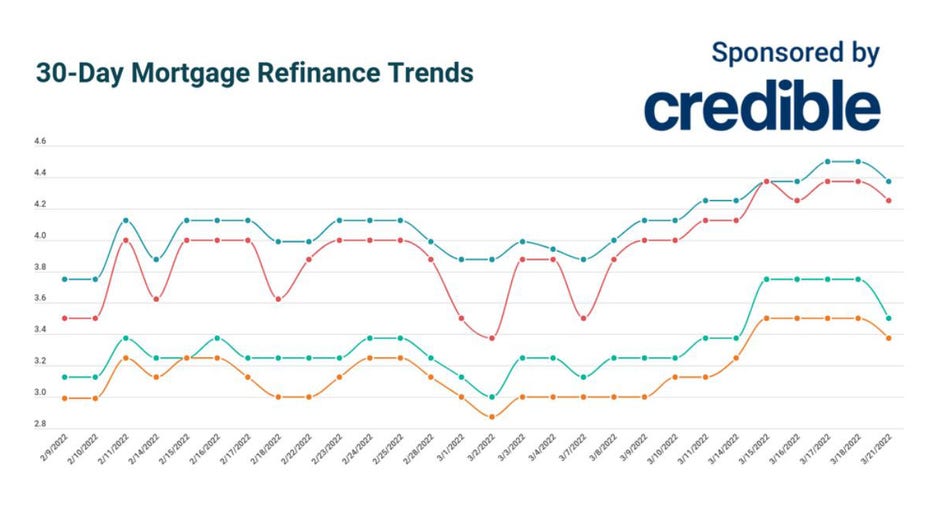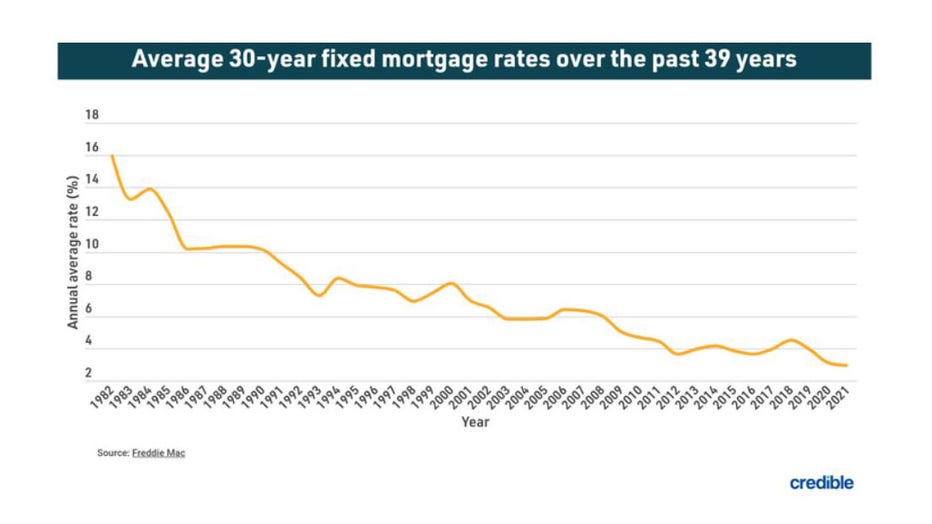Today’s mortgage refinance rates drop across all terms | March 21, 2022
Our goal here at Credible Operations, Inc., NMLS Number 1681276, referred to as "Credible" below, is to give you the tools and confidence you need to improve your finances. Although we do promote products from our partner lenders, all opinions are our own.

Based on data compiled by Credible, mortgage refinance rates have fallen across all terms since last Friday.
- 30-year fixed-rate refinance: 4.375%, down from 4.500%, -0.125
- 20-year fixed-rate refinance: 4.250%, down from 4.375%, -0.125
- 15-year fixed-rate refinance: 3.500%, down from 3.750%, -0.250
- 10-year fixed-rate refinance: 3.375%, down from 3.500%, -0.125
Rates last updated on March 21, 2022. These rates are based on the assumptions shown here. Actual rates may vary.
If you’re thinking of doing a cash-out refinance or refinancing your home mortgage to lower your interest rate, consider using Credible. Credible's free online tool will let you compare rates from multiple mortgage lenders. You can see prequalified rates in as little as three minutes.
What this means: Homeowners who took out their mortgages in 2019 or earlier, when rates were much higher, could stand to save significantly on interest by refinancing today. While rates for longer terms remain above 4%, they’ve edged down since last Friday. Rates for 15- and 10-year terms continue to offer the most money-saving opportunities for homeowners looking to refinance. At just 3.500% and 3.375%, homeowners who can swing a higher monthly payment can realize interest savings with a shorter term while paying off their mortgages much sooner.
WHAT IS CASH-OUT REFINANCING AND HOW DOES IT WORK?
How mortgage rates have changed over time
Today’s mortgage interest rates are well below the highest annual average rate recorded by Freddie Mac — 16.63% in 1981. A year before the COVID-19 pandemic upended economies across the world, the average interest rate for a 30-year fixed-rate mortgage for 2019 was 3.94%. The average rate for 2021 was 2.96%, the lowest annual average in 30 years.
The historic drop in interest rates means homeowners who have mortgages from 2019 and older could potentially realize significant interest savings by refinancing with one of today’s lower interest rates.

If you’re ready to take advantage of current mortgage refinance rates that are below average historical lows, you can use Credible to check rates from multiple lenders.
How to get your lowest mortgage refinance rate
If you’re interested in refinancing your mortgage, improving your credit score and paying down any other debt could secure you a lower rate. It’s also a good idea to compare rates from different lenders if you're hoping to refinance so you can find the best rate for your situation.
Borrowers can save $1,500 on average over the life of their loan by shopping for just one additional rate quote, and an average of $3,000 by comparing five rate quotes, according to research from Freddie Mac.
Be sure to shop around and compare current mortgage rates from multiple mortgage lenders if you decide to refinance your mortgage. You can do this easily with Credible’s free online tool and see your prequalified rates in only three minutes.
How does Credible calculate refinance rates?
Changing economic conditions, central bank policy decisions, investor sentiment and other factors influence the movement of mortgage refinance rates. Credible average mortgage refinance rates reported in this article are calculated based on information provided by partner lenders who pay compensation to Credible.
The rates assume a borrower has a 740 credit score and is borrowing a conventional loan for a single-family home that will be their primary residence. The rates also assume no (or very low) discount points and a down payment of 20%.
Credible mortgage refinance rates reported here will only give you an idea of current average rates. The rate you receive can vary based on a number of factors.
Think it might be the right time to refinance? Be sure to shop around and compare rates with multiple mortgage lenders. You can do this easily with Credible and see your prequalified rates in only three minutes.
How much equity do I need to refinance my home?
When you apply for a refinance mortgage, lenders will consider how much equity you currently have in your home. If you don’t meet the lender’s equity requirements, you may not qualify for a refinance with that lender.
Requirements can vary from lender to lender, and depend on the type of refinance you’re doing — rate-and-term vs. cash-out refinance.
For a rate-and-term refinance, you may be able to qualify with as little as 5% home equity. But your lender will likely require you to purchase private mortgage insurance. Most lenders will prefer a loan-to-value ratio of at least 20% — meaning the amount you owe on your mortgage is no more than 80% of your home’s total value.
Generally, for a cash-out refinance, most lenders will want to see that you have a loan-to-value ratio, or LTV, of at least 20%. But some lenders may be flexible if you have good credit, a history of on-time bill payments and are willing to accept a higher interest rate.
To calculate your loan-to-value ratio, simply divide your loan balance by the current value of your home. For example, if your home’s value is $350,000 and you owe $325,000, your LTV is just under 93% — and you may have difficulty qualifying for a refinance.
Have a finance-related question, but don't know who to ask? Email The Credible Money Expert at moneyexpert@credible.com and your question might be answered by Credible in our Money Expert column.
As a Credible authority on mortgages and personal finance, Chris Jennings has covered topics that include mortgage loans, mortgage refinancing, and more. He’s been an editor and editorial assistant in the online personal finance space for four years. His work has been featured by MSN, AOL, Yahoo Finance, and more.

